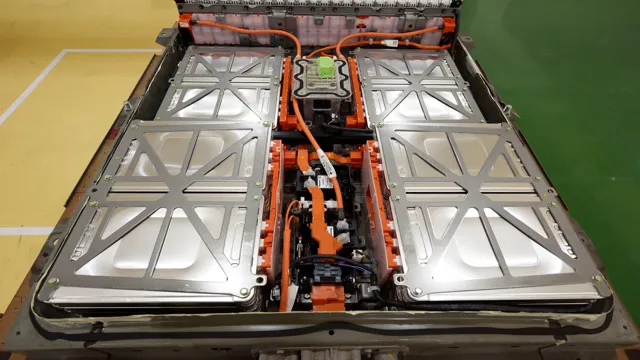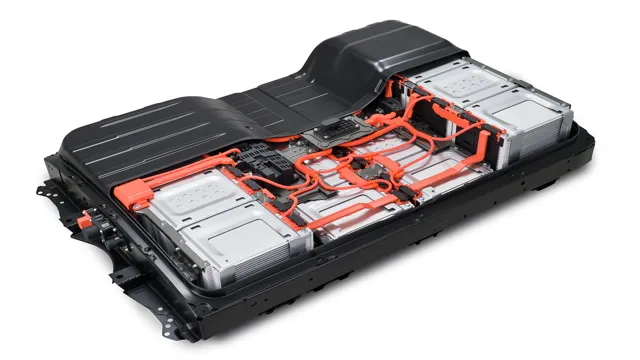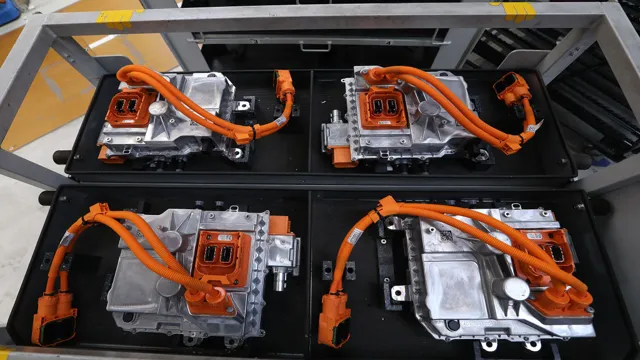Revolutionizing the Electric Vehicle Industry: How Fans Keep Batteries Cool for Optimal Performance
The Importance of Cooling Electric Car Batteries
One of the crucial aspects of electric vehicle maintenance is ensuring the batteries stay cool. This is because excessive heat can cause battery chemicals to degrade, leading to reduced performance and overall lifespan. To cool the batteries, many electric car manufacturers rely on fans.
These fans help regulate the temperature by blowing air over the batteries, dissipating the heat produced during charging or discharging. Without this cooling system, the batteries could overheat, leading to permanent damage or even fire. Thus, proper cooling is paramount to ensure the longevity and safety of electric vehicle batteries.
So, the next time you see those fans on your electric car, know that they play an essential role in keeping your ride running smoothly.
Efficiency and battery life
When it comes to electric cars, one of the most crucial factors for efficient operation and longer battery life is proper cooling. Batteries generate a lot of heat while in use, and if they get too hot, it can cause damage to the cells and reduce overall performance. That’s why many electric cars come equipped with cooling systems that help regulate temperature and keep batteries from overheating.
A well-designed cooling system not only preserves the battery’s longevity but also increases the vehicle’s efficiency and overall range. Think of it like the air conditioner in your home. If it’s not functioning correctly, your house will become uncomfortable, and your energy bills will skyrocket.
The same concept applies to electric cars and battery cooling. In short, it’s essential to prioritize proper cooling systems if we want to maximize electric car performance, battery life and grow the electric vehicle market.
Avoiding overheating and fire risks
The importance of cooling electric car batteries cannot be overstated. Overheating of batteries is a significant safety concern that could lead to fires and damage to the vehicle. With the increasing demand for electric cars, the need for efficient battery cooling systems has become even more apparent.
Liquid cooling systems are commonly used to maintain the battery’s temperature within an optimal range by circulating a coolant fluid through the battery pack. These cooling systems not only prolong the battery life but also enhance the car’s performance by allowing for faster charging and high-speed driving without risking overheating. Electric vehicle manufacturers must prioritize implementing reliable battery cooling systems that ensure the safety of passengers and the vehicle’s longevity.
Continuous advancements in battery technology and cooling systems design are necessary to meet the growing demand for electric cars and ensure their sustainability.

How Car Battery Cooling Systems Work
Batteries in electric cars being cooled by fans is one of the ways to ensure the longevity and efficiency of the battery. Cooling fans are integrated into the car’s battery management system and work by circulating air through the battery pack to regulate its temperature. The fans are triggered when the battery reaches a certain temperature above its optimum operating range.
This cooling process is essential, especially during long drives or high-speed driving, where the battery generates a significant amount of heat that could cause it to degrade faster and lose some of its power. The fans work by expelling hot air from the battery pack and bringing in cooler air to keep the battery at the right temperature. In the event of extreme temperatures, other cooling methods may kick in, such as liquid cooling or phase-change materials.
Nevertheless, cooling fans provide an efficient, cost-effective way to regulate the temperature of the battery and ensure optimal performance over the life of the car.
Fan cooling systems explained
When it comes to keeping your car battery cool, fan cooling systems play a vital role. These systems are designed to ensure that the battery doesn’t overheat, which can cause serious damage to the battery and even the car itself. Fan cooling systems work by circulating air around the battery to dissipate any heat that might build up.
This, in turn, helps to keep the battery at a safe temperature and ensures that it continues to function properly. The fan cooling system is typically controlled by a temperature sensor that detects when the battery is getting too hot and activates the fan to cool it down. So, the next time you notice a fan running near your car battery, rest assured that it’s doing its job to keep your car running smoothly and prevent any potential damage.
Comparing liquid cooling systems
Car battery cooling systems are a crucial component of modern day electric vehicles. These systems are designed to dissipate the heat produced by the battery during its use, and maintain it within an optimal temperature range to ensure stable performance and longevity. There are several different types of car battery cooling systems available, with the most common being the liquid cooling system.
This system involves the use of a network of tubes and pumps filled with coolant that circulates around the battery pack, absorbing heat and transporting it to a radiator where it is dissipated into the air. By keeping the battery cool, a liquid cooling system helps to prevent damage and extend the life of the battery. However, the complexity and cost of these systems can vary depending on the specific application, and there are other systems available such as air and phase-change cooling that may be better suited for certain scenarios.
Therefore, it is important to carefully consider the requirements and limitations of a given situation before selecting a car battery cooling system that will deliver the desired performance and reliability.
Benefits and drawbacks of each
Car battery cooling systems play a critical role in optimizing the performance and longevity of your car’s battery. In essence, these systems work by dissipating excess heat from the battery, preventing overheating and damage to the internal components. One benefit of such cooling systems is that they help to extend the battery’s lifespan, reducing the need for frequent replacements.
Moreover, this technology improves the overall efficiency of your car, leading to better fuel economy and fewer emissions. However, as with any system, there are a few drawbacks to keep in mind. One potential issue is the added weight and complexity of the cooling system, which can increase the cost and maintenance needs of your vehicle.
Additionally, some cooling systems may produce excess noise or vibrations, which may be a concern for some drivers. Nevertheless, the benefits of car battery cooling systems generally outweigh the drawbacks, making them an essential component for maximizing the performance and longevity of your car’s battery.
Impact on Electric Car Performance
Batteries in electric cars can overheat and suffer from a decrease in performance if not properly cooled. Fans are often used to keep the batteries at an optimal temperature while also optimizing the car’s performance. These fans work by creating a flow of air over the batteries, which helps to move heat away from the cells.
By keeping the battery cool, the car can operate at higher speeds and for longer periods of time without the risk of overheating. When it comes to electric vehicles, battery life and performance are directly related, so ensuring proper cooling of the battery is essential. Without a cooling system, an electric car’s battery can quickly degrade and end up costing a lot of money to repair or replace.
Therefore, fans are a staple in the electric car industry, and advancements in fan technology are continuously being made to guarantee maximum impact on electric car performance.
Effect on battery range and charging time
When it comes to electric car performance, a significant factor to consider is the impact on battery range and charging time. With the continued advancements in electric vehicle technology, there has been a steady increase in the range of electric cars, and charging times have significantly reduced. However, the increased use of high-power systems in electric cars may impact the battery’s lifespan and performance, ultimately affecting the vehicle’s range and charging times.
Additionally, driving style and environmental factors such as temperature can also impact battery range, making it important for drivers to adopt efficient driving practices and take into account the conditions they are driving in. Overall, electric car performance in terms of battery range and charging time continues to improve, with new advancements in technology making these vehicles a viable and sustainable option for drivers.
Influence on overall vehicle efficiency
When it comes to electric cars, the battery is the heart of the vehicle. It’s responsible for storing and supplying the energy needed to power the car’s electric motor. However, the battery doesn’t work alone, and other factors must be considered when analyzing an electric car’s performance.
Other factors, such as the car’s aerodynamics and weight, impact the battery’s efficiency, thereby influencing overall vehicle efficiency. The design of the car and the materials used can affect how the car moves through the air and the amount of energy needed to maintain a certain speed. Similarly, a heavier car requires more energy to move, reducing battery life and range.
Thus, optimizing the design and reducing weight can increase the battery’s efficiency and overall vehicle performance. Electric cars have come a long way in recent years, and advancements in battery technology, materials, and design have boosted their performance, making them much more viable as alternative modes of transportation.
Future Innovations in Car Battery Cooling
One of the most important components of an electric car is the battery, and keeping it cool is a crucial factor in maintaining its longevity and efficiency. One innovative method of cooling batteries in electric cars is through the use of fans. By utilizing fans, cool air is circulated around the battery pack, preventing it from overheating and increasing its lifespan.
However, the future of battery cooling involves much more advanced technologies, such as liquid cooling and phase change materials. These innovations promise to significantly improve battery efficiency and performance, ultimately leading to longer ranges and faster-charging times. With the increasing demand for electric vehicles, the race to develop the most advanced and efficient battery cooling solutions is on, and the possibilities for future innovations in this area are exciting.
Advancements in cooling technology
Car Battery Cooling As cars are becoming more advanced with electric technology, the demand for efficient and reliable car battery cooling systems is increasing. Manufacturers are constantly innovating to improve the longevity and performance of car batteries, with several future innovations in the works. One such innovation is thermoelectric cooling, which uses the Peltier effect to transfer heat away from the battery.
This technology has already been used in laptops and refrigerators and is being adapted for use in cars. Another promising innovation is phase-change materials that absorb and release heat as they change phase, providing effective thermal management. Additionally, researchers are exploring the use of nanofluids that contain nanoparticles to enhance heat dissipation.
These advancements in car battery cooling technology will not only increase the lifespan of batteries but also improve the overall efficiency of electric cars.
Potential for longer battery life
Car Battery Cooling As electric cars continue to gain popularity, one of the major concerns has been how to improve their battery life. However, future innovations in car battery cooling may help alleviate this issue. Battery cooling is crucial in maintaining optimal temperature conditions that, in turn, increase the lifespan of a battery.
Currently, electric cars use liquid cooling systems to keep their batteries at an optimal temperature, but new cooling technologies that are being developed will be even more efficient. These new systems will be designed to better regulate temperature and reduce the burden on the car’s battery, potentially extending its lifespan and overall driving range. With these new innovations, the future looks bright for electric cars, and we can expect even longer-lasting batteries in the coming years.
Potential for faster charging times
In the world of electric vehicles, one of the biggest challenges is to reduce charging times. Fortunately, futuristic innovations in car battery cooling may hold the key to faster charging. Car batteries can overheat during charging, which can result in damage and slower charging times.
In response, engineers are developing new technologies to enhance battery cooling. For instance, researchers are exploring the use of Phase Changing Materials (PCMs) to store and release heat throughout the charging process. Another option is the use of immersion cooling, where batteries are submerged in a coolant liquid to regulate temperatures.
By minimizing overheating and streamlining the charging process, these innovations could transform the world of electric vehicles, making them faster and more efficient. The potential for improved charging times is an exciting prospect for consumers and the EV industry as a whole.
Conclusion
In the world of electric cars, keeping the batteries cool is key to prolonging their life and ensuring optimal performance. And what better way to keep things cool than with a trusty fan? These miniature wind machines bring a breath of fresh air to the muggy world of battery storage, helping to dissipate excess heat and keep those power-hungry cells in top form. So next time you’re driving down the highway in your electric vehicle, take a moment to appreciate the cool breeze coming from your battery compartment.
Who knew that fans weren’t just for keeping us humans comfortable, but could also be a lifesaver for our precious batteries? Keep calm and fan on, electric car enthusiasts!”
FAQs
Why do electric cars have fans to cool their batteries?
Electric car batteries can overheat during use, which can cause damage to the battery cells and decrease their lifespan. Fans are used to cool off the batteries, which helps to prevent overheating and maintain optimal performance.
How effective are fans at cooling electric car batteries?
Fans are a very effective way to cool electric car batteries, especially when combined with other cooling systems like liquid cooling. Studies have shown that using fans to cool batteries can help increase their lifespan and maintain their performance.
Can fans cause damage to electric car batteries?
While fans are designed to cool batteries and prevent overheating, they can potentially cause damage if they are not properly installed or maintained. For example, if the fan motor fails or the fan blades become damaged, they could create vibrations or heat that could damage the battery cells.
What happens if electric car batteries overheat?
If electric car batteries overheat, they can become damaged and lose their ability to store and release energy effectively. In extreme cases, overheating can even cause fires or explosions. That is why it is so important to keep electric car batteries properly cooled and working efficiently.





